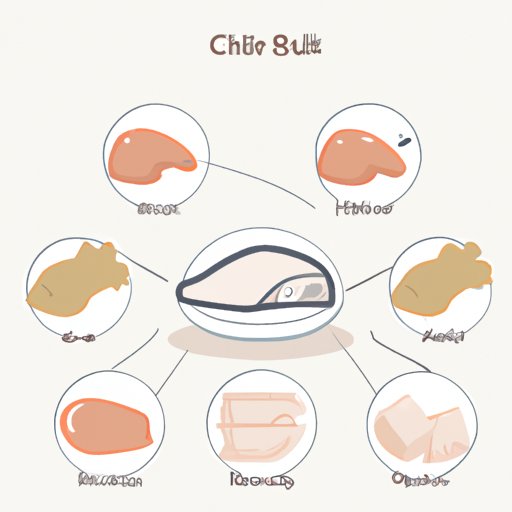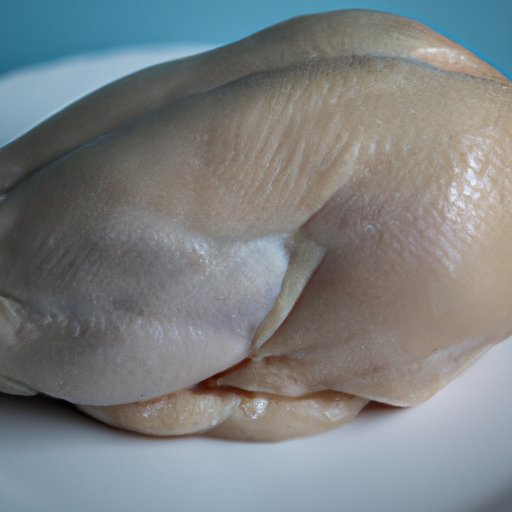I. Introduction
Boiling chicken breast is a common method of cooking for many people. It is simple, versatile, and convenient. However, some people may find it challenging to boil chicken breast perfectly every time, resulting in dry, unappetizing meat. In this article, we will explore how to boil chicken breast to perfection, including tips and tricks to ensure your chicken is juicy and flavorful every time.
II. Step-by-Step Guide on How to Boil Chicken Breast Perfectly Every Time
Boiling chicken breast may seem like a straightforward process, but there are certain steps you can follow to ensure that your chicken is cooked evenly and stays juicy throughout:
1. Preparing the chicken breast
Trim any excess fat from the chicken breast and remove the skin, as these can result in a greasy and fatty finished product. You may also want to pound the chicken breast to an even thickness to ensure it cooks evenly.
2. Filling a pot with enough water to cover the chicken breast
Place the chicken breast in a large pot and fill with enough water to cover the chicken completely.
3. Adding spices, herbs, or aromatics for flavor (optional)
You can add various spices, herbs, or aromatics to the water to add flavor to the chicken, such as salt, pepper, garlic, onion, bay leaves, or thyme.
4. Bringing the water to a boil
Place the pot on the stove and bring the water to a rolling boil over medium-high heat.
5. Adding the chicken breast to the pot
Once the water is boiling, add the chicken breast to the pot. Be careful to not overcrowd the pot, as this can prevent the chicken from cooking evenly.
6. Letting the chicken breast cook for 10-12 minutes
Cook the chicken breast for 10-12 minutes, or until its internal temperature reaches 165°F (74°C). To ensure even cooking, you can turn the chicken breast over halfway through the cooking time.
7. Removing the chicken breast from the pot and letting it rest
Once cooked, remove the chicken breast from the pot using tongs and place it on a cutting board. Let it rest for a few minutes to allow the juices to redistribute, making the chicken more moist and flavorful.
8. Slicing or shredding the chicken breast for serving
You can slice the chicken breast into thin pieces or shred it using two forks. You can serve the chicken breast hot, cold, or at room temperature, depending on your preference.
III. 5 Tried and Tested Tips to Ensure Your Boiled Chicken Breast is Always Juicy
Here are five tips you can follow to ensure your boiled chicken breast is always juicy and flavorful:
1. Using bone-in chicken breast
Chicken breast with the bone still intact will cook more evenly and retain more moisture than boneless chicken breast.
2. Adding salt to the water before boiling
Adding salt to the water can help to season the chicken breast from the inside out and make it more flavorful.
3. Covering the pot while cooking
Covering the pot with a lid will help to keep the heat and moisture in, resulting in juicier chicken breast.
4. Checking the temperature of the chicken breast using a meat thermometer
Using a meat thermometer to check the internal temperature of the chicken is the most accurate way to determine if it is cooked through. Insert the thermometer into the thickest part of the chicken breast, being careful not to touch the bone.
5. Letting the chicken breast rest for a few minutes before cutting
Allowing the chicken breast to rest for a few minutes after it has been cooked will help the juices redistribute throughout the meat, making it more tender and juicy.

IV. The Health Benefits of Boiled Chicken Breast and How to Cook It to Maximize Its Nutritional Value
Boiled chicken breast is a healthy and nutritious protein source that is low in fat and high in protein. Here are some tips to maximize the nutritional value of boiled chicken breast:
1. High in protein and low in fat
Chicken breast is an excellent source of high-quality protein, containing all nine essential amino acids necessary for optimal health. It is also low in fat, making it a healthy option for those watching their calorie intake or looking to maintain a healthy weight.
2. How to minimize nutrient loss when boiling chicken breast
To minimize nutrient loss when boiling chicken breast, avoid overcooking it, as this can cause the protein to denature and lose its nutritional quality. Additionally, you can add nutrient-rich vegetables, such as carrots, celery, or onions, to the pot to infuse more nutrients into the cooking liquid.
3. Including vegetables or whole grains to make it a nutritious meal
You can serve boiled chicken breast with a variety of nutrient-rich sides, such as roasted or steamed vegetables, whole grains, or a side salad, to make it a well-rounded and healthy meal.
V. Quick and Easy Boiled Chicken Breast Meal Ideas for Busy Weeknights
Boiled chicken breast is a versatile ingredient that can be used in countless meal ideas, such as:
1. Shredding the chicken breast to use in tacos or wraps
You can shred the boiled chicken breast and use it as a filling in tacos, wraps, or sandwiches, along with your favorite veggies and condiments.
2. Slicing it and serving it with a salad
You can slice the chicken breast and serve it on top of a bed of mixed greens and vegetables, along with a homemade vinaigrette or avocado dressing.
3. Including it in a stir-fry or soup
You can add boiled chicken breast to stir-fries, soups, or stews for added protein and flavor.
VI. How to Season and Flavor Boiled Chicken Breast for Added Taste
While boiled chicken breast can be delicious on its own, you can add various seasonings and flavors to it to enhance its taste, such as:
1. Using spices and herbs like garlic, onion, paprika, thyme, and rosemary
You can use various dried or fresh spices and herbs to season the chicken breast before boiling, or add them to the water for added flavor.
2. Marinating the chicken breast before boiling
You can marinate the chicken breast in your favorite blend of herbs, spices, and acid (such as lemon juice or vinegar) for a few hours or overnight before boiling to infuse more flavor into the meat.
3. Adding a sauce or dressing after boiling
You can drizzle the boiled chicken breast with a variety of sauces and dressings, such as BBQ sauce, honey mustard, pesto, or salsa, to add more flavor and complexity to the dish.
VII. A Comparison Between Boiled and Baked Chicken Breast with Pros and Cons to Help You Decide Which One to Choose
While boiled chicken breast is a quick and easy method of cooking, baking chicken breast is another common method that results in a different taste and texture. Here are some pros and cons to help you decide which method is best for you:
1. Boiled chicken breast
Pros:
- Fast and convenient
- Requires minimal prep time
- Results in a moist and tender meat, especially if you follow the tips outlined above
Cons:
- May be less flavorful than baked chicken breast
- Lacks crispy skin or browned edges
2. Baked chicken breast
Pros:
- Results in a crispy skin and browned edges, which adds depth of flavor
- You can use various seasoning blends or marinades to enhance its taste
- Can be baked with vegetables or potatoes to make it a one-pan meal
Cons:
- Requires more time and prep work, such as marinating or rubbing with spices
- May be less moist and tender than boiled chicken breast
VIII. Tips on How to Know When Boiled Chicken Breast is Cooked and How to Avoid Overcooking It
To avoid undercooking or overcooking your boiled chicken breast, follow these tips:
1. Checking the internal temperature with a meat thermometer
Checking the internal temperature of the chicken breast with a meat thermometer is the most accurate way to determine if it is cooked through. Aim for 165°F (74°C) at the thickest part of the meat, being careful not to touch the bone.
2. Slicing the chicken breast to check its color and texture
You can slice the chicken breast with a sharp knife to check its color and texture. The meat should be white or slightly pink, with no signs of red or rawness. The texture should be firm but not rubbery, indicating that it is cooked through and tender.
3. Avoiding boiling the chicken breast for too long
Boiling the chicken breast for too long can result in overcooked, dry meat. Follow the cooking times outlined above, and check the meat frequently to avoid overcooking it.
IX. Conclusion
Boiled chicken breast is a simple and healthy way to cook this versatile protein source. By following the steps and tips outlined in this article, you can ensure that your chicken breast is perfectly cooked every time, and packed with flavor and nutrition. Whether you prefer it hot or cold, sliced or shredded, there are countless ways to enjoy boiled chicken breast as part of a balanced and nutritious diet.
